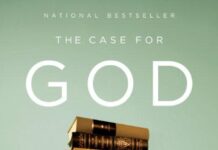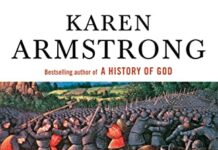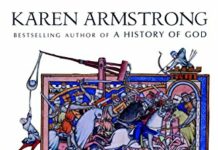
Ebook Info
- Published: 2006
- Number of pages: 592 pages
- Format: EPUB
- File Size: 1.82 MB
- Authors: Karen Armstrong
Description
NATIONAL BESTSELLER • An extraordinary investigation of a critical moment in the evolution of religious thought—from the New York Times bestselling author of A History of God and The Spiral Staircase“A splendid book…. Lucid, highly readable…. Relevant to a world still embroiled in military conflict and sectarian hatreds.” —The New York TimesIn the ninth century BCE, events in four regions of the civilized world led to the rise of religious traditions that have endured to the present day—development of Confucianism and Daoism in China, Hinduism and Buddhism in India, monotheism in Israel, and philosophical rationalism in Greece. Armstrong, one of our most prominent religious scholars, examines how these traditions began in response to the violence of their time. Studying figures as diverse as the Buddha and Socrates, Confucius and Jeremiah, Armstrong reveals how these still enduring philosophies can help address our contemporary problems.
User’s Reviews
Reviews from Amazon users which were colected at the time this book was published on the website:
⭐Karen Armstrong refer to it as the Axial Age. It was a period of time between 900 to 200 BC where in 4 distinct regions the great world traditions came into being: Confucianism and Daoism in China, Hinduism and Buddhism in India, monotheism in Israel, and mythology and philosophical rationalism in Greece.These traditions bring us the likes of Socrates, Plato, Buddha, Confucius, Jeremiah, Euprides, Mencius, and the mystics of Upanishads. Even today, in times of spiritual and social crisis we constantly referred back to this period of time for guidance, as Rabbinic Judaism, Christianity, and Islam were all latter-day flowering of the original Axial Age.So what prompted these 4 regions to develop a similar philosophy?This book is about the history of that period of time. It is about the people and the conflicts, the drama, and the reconciliations. About how spiritual and religious lives evolved, with all the stories exquisitely told in impressive detail and reads like 4 different epic colossal movies. It is quite literally 4 big historical accounts combined into one dense narrative.Now, due to its incredible wealth of knowledge this book is not only heavy to read, but also challenging to summarize. But here are the 5 main points that I learned from the book:Firstly, the 4 Axial Age traditions were born out of a reaction of their respective circumstance of the time. Confucius was born in the middle of lawless, battle-torn, region. The birth of the dark Greek mythology stems from a period of 400 years of darkness in that region due to war and hardship. The Axial Age in India began when the ritual reformers began to extract the conflict and agression from the sacrificial contest. While Israel started their Axial Age after the destruction of Jerusalem and the enforced deportation of the exiles to Babylonia, which then the priestly writers began to create a philosophy of reconciliation and non-violence.Even in what Armstrong refer as “the final flowering of the Axial Age”, the prophet Muhammad (PBUH) lived in a violent society when old values were breaking down, before Islam arrises. Indeed, as Armstrong remarks, “[t]he religious traditions created during the Axial Age in all four regions were rooted in fear and pain.”The second point of the book is, when the environment changes the religion changes along with it. One of the most common occurances of change is political move, which can sometimes include or emit a deity from a culture. For example, when King Solomon made diplomatic marriages with foreign princesses, the marriages include the merging of the gods in the royal cult, where they built temples for them in the hills outside Jerusalem.Another example of the politics of gods is the story of Elijah. In the old Middle Eastern theology, El had appointed a deity to each of the nations: Yahweh was the god of Israel, Chemish the holy one of Moab, while Milkom was the god of Ammon. But some Israelites prophets felt that their god Yahweh would be undermined in the region if a king imported a foreign deity into the royal cult. Hence, during his time, Elijah tried to keep the god of Baal in Phonecia so that Yahweh would remain thriving as the local god, where the brutal story on how exactly he did it was told grippingly in the book.Meanwhile, Yahweh Himself was originally one god among many others (He was a god of war), but later in the 6th century BC as the circumstances changed He too evolved to become the only God in the eyes of the worshipers, which in turn evolved to eventually become the sole God that we familiar with today.Thirdly, when the religion gets too brutal or corrupted there will be a breakaway sect, such as Christianity from Judaism, Protestants from Catholic, and the many religion out of Hinduism like Buddhism, Jainism, and Sikhism, while Islam fixed the problems of old Pagan faith that was no longer working in Arabian society.Fourthly, all of the Axial Age changes had often occurred between two imperial-style ventures. The Indian Axial Age occurred after the demise of the Harappan Civilization and ended with the rise of the Mauryan empire. The Greek Axial Age transformation occurred between the Mycenaean kingdom and the Macedonian empire. The Chinese Axial Age got under way after the collapse of the Zhou dynasty and ended when Qin unified the warring states. And the Jews, who had suffered horribly from the imperial adventures in the region, had been propelled into their Axial Age after the destruction of their homeland and the trauma of deportation that severed their link with their past and thus forced them to start again.And lastly, most of the Axial Age sages did not leave a book. Instead, their teachings were passed on orally, which was the custom back then. And their wisdom were eventually written down as a holy text long after they’re gone, which as you can imagine could be exposed to the many risks of human errors or misquotations or hidden agenda of the writers.Hence, everything that have been written down ever since, everything that we now know in the modern society, are the product of many environmental changes, compromises, evolution, revolution, mergers and acquisitions, or even anihilation of deities and cults over a long and turmulous period of time.So, in short: 1. The Axial Age were born as a response of a violent era 2. When the environment changes the religion changes with it 3. When the religion gets too brutal or corrupted there will be a breakaway sect 4. The Axial Age occurred between two imperial-style ventures 5. Most of the Axial Age sages did not leave a book, and their written wisdom could be exposed to the many “agency problems.”seeing this summary might prompt us to ask the next question: will this pattern repeat itself? Karen Armstrong remarks that reformation should be happening all the time, that religion cannot stand still. Because if they cannot adapt they will become obsolete and fade away, just like the many religious cults mentioned in the book that did not survive the Axial Age. And yes, according to Armstrong, we are now in the midst of a Second Axial Age.
⭐My first comment is that the Amazon post from Publishers Weekly (pasted here) needs an editor..Karl Jung is not the one who coined the term Axial Age. It was Karl Jaspers.Furthermore, the review is sensationalistic and misses the key points of Armstrong’s work.”It’s not what one may expect from a book about the development of the world’s religions: ‘Crouched in his mother’s womb, he lay in wait for his father, armed with a sickle, and the next time Uranus penetrated Gaia, he cut off his genitals and threw them to the earth.’ However, the Greek myth of Cronus clearly illustrates Armstrong’s main thesis, that the ‘simultaneous’ development of the world’s religions during what Karl Jung called the axial age, is a direct result of the violence and chaos, both physical and spiritual, of past civilizations. Armstrong, a former nun turned self-described ‘freelance monotheist,’ has enough background and personal investment in the material to make it come alive. Her delivery is crystal clear, informative and, though somewhat academic, easy for the layman to understand. Her voice is straightforward yet wrought with palpable concern. This reinforces the book’s goals of creating a clear understanding of where religious developments have come from and explaining how today’s ‘violence of an unprecedented scale’ parallels the activities that created the ‘axial age’ in the first place.”In The Great Transformation (TGT) Armstrong meticulously, but without losing energy, explores the emergence of the pivotal religions of the world that emerged from c. 900 to c. 200 BCE. Her treatment is, first of all, historical and cultural, with emphases upon India (Hinduism and Buddhism), China (Taoism and Confucianism), the Middle East (Judaism), and ancient Greece.Although Armstrong often is tagged as a comparative religion scholar/writer, she is less interested in comparing religions (comparisons almost always devolve into value assessments that fuel competitive approaches to religion) than she is showing how diverse histories and cultures leave us with deep resonances of religious and spiritual awareness.Those resonances–including ritual, kenosis (emptying), knowledge, suffering, empathy, and concern for everybody–provide the clues to a careful reader to help understand how regional/cultural/historical expressions of religion finally transcended those beginnings and became viable across cultures and eras in history.The transformation suggested in the book’s title is kaleidoscopic. From time to time and from place to place the resonances emerge from particular circumstances and move toward universally recognized traits of authentic, transformative religions.A delight found in each chapter is Armstrong’s judicious use of primary sacred texts–yes, including Homer’s epics and the Greek dramatists broad ouvre–that contextualize the values of religion without attempting to put all religions in one proverbial pot.Finally, TGT begins with reflections upon recent history (e.g., the fall of the Twin Towers in 2001) and the rise of the perceived certainties of science and technology that have had the effect of muting the myths and mysteries found in the history of religions. Armstrong’s closing parenthesis, “The Way Forward,” holds out the hope those seeking to survive the twenty-first century might find, again, the values of myth and mysteries from ancient and contemporary flowerings of Axial Religion.
⭐Book arrived on time in condition described.
⭐fascinating book
⭐Excellent book to understand and appreciate evolution of different religions and philosophies in India, China, Middle East and Greece, during the first millennia BCE. Gives us a glimpse of life then with the historical context of what the author calls, the Axial Age.
⭐Karen Armstrong gives amazing clarity and insight to the root of spiritual development that in its diversity defines the potential of human nature.
⭐The rating is for binding of the book which is terribly poor… Don’t buy the paperback version..
Keywords
Free Download The Great Transformation: The Beginning of Our Religious Traditions in EPUB format
The Great Transformation: The Beginning of Our Religious Traditions EPUB Free Download
Download The Great Transformation: The Beginning of Our Religious Traditions 2006 EPUB Free
The Great Transformation: The Beginning of Our Religious Traditions 2006 EPUB Free Download
Download The Great Transformation: The Beginning of Our Religious Traditions EPUB
Free Download Ebook The Great Transformation: The Beginning of Our Religious Traditions



